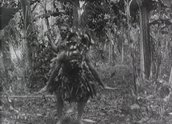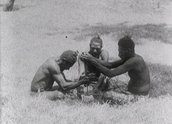


Torres Strait Islanders (1898)
Synopsis
Torres Strait Islanders contains the surviving four-and-a-half minutes of footage shot by AC Haddon during an expedition conducted by Cambridge University to Murray Island in the Torres Straits, in 1898. Composed of five short sequences, this film is the world’s first field footage of Indigenous peoples in Australia.
Made three years after the invention of the cine-camera, this film shows Torres Strait Islander men performing three dance sequences, one of which is shown in clip one. This is followed by a demonstration of traditional fire-making practices (see clip two). The last part of the film (clip three) shows two short dances performances by young Aboriginal men, who travelled to Murray Island from the mainland on a bêche-de-mer (sea cucumber) fishing boat.
Just over a minute of footage exists of the spectacular Malu-Bomai ceremony performed by the Torres Strait Islander men of Mer at Kiam, in the eastern Torres Strait. In the other two dance sequences, both shot at the same location on the beach, three men wear traditional headdresses and dance in synchronisation.
The final sequence shows four young Australian Aboriginal men performing a shake-a-leg dance on the beach, while another beats the rhythm.
Curator’s notes
In 1898, after an expedition ten years earlier, AC Haddon, a British zoologist from Cambridge University, returned to the Torres Strait Islands in far north Queensland accompanied by a team of scientists.
The expedition stayed for seven months producing approximately 100 wax cylinder recordings of Torres Strait Islander people’s language and song. Three days before the expedition ended, Haddon received his new 35mm Newman and Guardia movie camera. As a result he only managed to produce a small amount of film material.
The Aboriginal and Islander men in the film clearly demonstrate agency as they engage with the camera. From the inception of the technology Aboriginal peoples actively participated in the production of an audio-visual record of their cultural performances. This form of interconnectedness, between the filmmaker and the performer, perfectly matched the Indigenous notion of cultural exchange and many of the filmmakers understood the reciprocal nature of this process.
The young Aboriginal men in the film wear islander-style sarongs and have customary designs painted on their bodies. These markings represent the cultural identity of each individual dancer and may be used to identify them with their country and clan group.
Haddon saw the movie camera as ‘an indispensable piece of anthropological apparatus’ and encouraged Walter Baldwin Spencer to take one on his expedition into central Australia in 1901. This film launched an ethnographic tradition in Australia that continued until the 1990s, producing many hours of film. Major filmmakers within this genre include Walter Baldwin Spencer, Charles Mountford, Adolphus Elkin (see Tribal Music of Australia), Norman B Tindale, EO Stocker, TGH Strehlow, Ian Dunlop, Cecil Holmes, Roger Sandall, Curtis Levy, David and Judith MacDougall and Kim McKenzie. Many of the films made by some of the earlier ethnographic filmmakers include culturally restricted materials.
- Overview
- Curator’s notes
- Video 3 clips
- Principal credits
- Find a copy
- Make a comment
- Map
- Add your review



